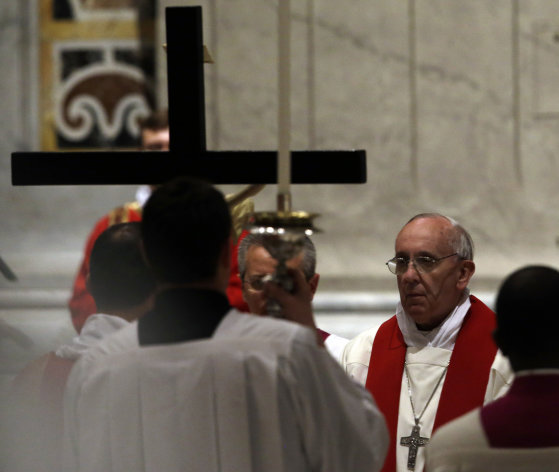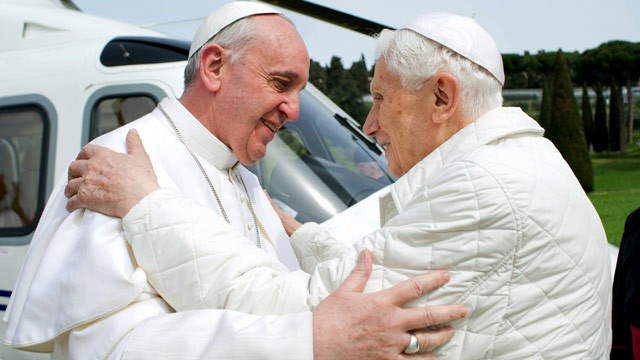Disclaimer: The AP thinks Jorge Bergoglio is a valid Pope, but true Traditionalists of the Catholic Religion reject him as an Antipope.
Pope's foot-wash a final straw for traditionalists
By NICOLE WINFIELD | Associated Press
Associated Press/Gregorio Borgia - Pope Francis, right, looks up to the Crucifix during the Passion of Christ Mass inside St. Peter's Basilica, at the Vatican, Friday, March 29, 2013. Pope Francis began the …more
VATICAN CITY (AP) — Pope Francis has won over many hearts and minds with his simple style and focus on serving the world's poorest, but he has devastated traditionalist Catholics who adored his predecessor, Benedict XVI, for restoring much of the traditional pomp to the papacy.
Francis' decision to disregard church law and wash the feet of two girls — a Serbian Muslim and an Italian Catholic — during a Holy Thursday ritual has become something of the final straw, evidence that Francis has little or no interest in one of the key priorities of Benedict's papacy: reviving the pre-Vatican II traditions of the Catholic Church.
One of the most-read traditionalist blogs, "Rorate Caeli," reacted to the foot-washing ceremony by declaring the death of Benedict's eight-year project to correct what he considered the botched interpretations of the Second Vatican Council's modernizing reforms.
"The official end of the reform of the reform — by example," ''Rorate Caeli" lamented in its report on Francis' Holy Thursday ritual.
A like-minded commentator in Francis' native Argentina, Marcelo Gonzalez at International Catholic Panorama, reacted to Francis' election with this phrase: "The Horror." Gonzalez's beef? While serving as the archbishop of Buenos Aires, the then-Cardinal Jorge Mario Bergoglio's efforts to revive the old Latin Mass so dear to Benedict and traditionalists were "non-existent."
Virtually everything he has done since being elected pope, every gesture, every decision, has rankled traditionalists in one way or another.
The night he was chosen pope, March 13, Francis emerged from the loggia of St. Peter's Basilica without the ermine-rimmed red velvet cape, or mozzetta, used by popes past for official duties, wearing instead the simple white cassock of the papacy. The cape has since come to symbolize his rejection of the trappings of the papacy and to some degree the pontificate of Benedict XVI, since the German pontiff relished in resurrecting many of the liturgical vestments of his predecessors.
Francis also received the cardinals' pledges of obedience after his election not from a chair on a pedestal as popes normally do but rather standing, on their same level. For traditionalists who fondly recall the days when popes were carried on a sedan chair, that may have stung. In the days since, he has called for "intensified" dialogue with Islam — a gesture that rubs traditionalists the wrong way because they view such a heavy focus on interfaith dialogue as a sign of religious relativism.
Francis may have rubbed salt into the wounds with his comments at the Good Friday procession at Rome's Colosseum, which re-enacts Jesus Christ's crucifixion, praising "the friendship of our Muslim brothers and sisters" during a prayer ceremony that recalled the suffering of Christians in the Middle East.
Francis also raised traditional eyebrows when he refused the golden pectoral cross offered to him right after his election by Monsignor Guido Marini, the Vatican's liturgy guru who under Benedict became the symbol of Benedict's effort to restore the Gregorian chant and heavy silk brocaded vestments of the pre-Vatican II liturgy to papal Masses.
Marini has gamely stayed by Francis' side as the new pope puts his own stamp on Vatican Masses with no-nonsense vestments and easy off-the-cuff homilies. But there is widespread expectation that Francis will soon name a new master of liturgical ceremonies more in line with his priorities of bringing the church and its message of love and service to ordinary people without the "high church" trappings of his predecessor.
There were certainly none of those trappings on display Thursday at the Casal del Marmo juvenile detention facility in Rome, where the 76-year-old Francis got down on his knees to wash and kiss the feet of 12 inmates, two of them women. The rite re-enacts Jesus' washing of the feet of his 12 apostles during the Last Supper before his crucifixion, a sign of his love and service to them.
The church's liturgical law holds that only men can participate in the rite, given that Jesus' apostles were all male. Priests and bishops have routinely petitioned for exemptions to include women, but the law is clear.
Francis, however, is the church's chief lawmaker, so in theory he can do whatever he wants.
"The pope does not need anybody's permission to make exceptions to how ecclesiastical law relates to him," noted conservative columnist Jimmy Akin in the National Catholic Register. But Akin echoed concerns raised by canon lawyer Edward Peters, an adviser to the Vatican's high court, that Francis was setting a "questionable example" by simply ignoring the church's own rules.
"People naturally imitate their leader. That's the whole point behind Jesus washing the disciples' feet. He was explicitly and intentionally setting an example for them," he said. "Pope Francis knows that he is setting an example."
The inclusion of women in the rite is problematic for some because it could be seen as an opening of sorts to women's ordination. The Catholic Church restricts the priesthood to men, arguing that Jesus and his 12 apostles were male.
Francis is clearly opposed to women's ordination. But by washing the feet of women, he jolted traditionalists who for years have been unbending in insisting that the ritual is for men only and proudly holding up as evidence documentation from the Vatican's liturgy office saying so.
"If someone is washing the feet of any females ... he is in violation of the Holy Thursday rubrics," Peters wrote in a 2006 article that he reposted earlier this month on his blog.
In the face of the pope doing that very thing, Peters and many conservative and traditionalist commentators have found themselves trying to put the best face on a situation they clearly don't like yet can't do much about lest they be openly voicing dissent with the pope.
By Thursday evening, Peters was saying that Francis had merely "disregarded" the law — not violated it.
The Rev. John Zuhlsdorf, a traditionalist blogger who has never shied from picking fights with priests, bishops or cardinals when liturgical abuses are concerned, had to measure his comments when the purported abuser was the pope himself.
"Before liberals and traditionalists both have a spittle-flecked nutty, each for their own reasons, try to figure out what he is trying to do," Zuhlsdorf wrote in a conciliatory piece.
But, in characteristic form, he added: "What liberals forget in their present crowing is that even as Francis makes himself — and the church — more popular by projecting (a) compassionate image, he will simultaneously make it harder for them to criticize him when he reaffirms the doctrinal points they want him to overturn."
One of the key barometers of how traditionalists view Francis concerns his take on the pre-Vatican II Latin Mass. The Second Vatican Council, the 1962-65 meetings that brought the church into the modern world, allowed the celebration of the Mass in the vernacular rather than Latin. In the decades that followed, the so-called Tridentine Rite fell out of use almost entirely.
Traditionalist Catholics who were attached to the old rite blame many of the ills afflicting the Catholic Church today — a drop in priestly vocations, empty pews in Europe and beyond — on the liturgical abuses that they say have proliferated with the celebration of the new form of Mass.
In a bid to reach out to them, Benedict in 2007 relaxed restrictions on celebrating the old Latin Mass. The move was aimed also at reconciling with a group of schismatic traditionalists, the Society of St. Pius X, who split from Rome precisely over the Vatican II reforms, in particular its call for Mass in the vernacular and outreach to other religions, especially Judaism and Islam.
Benedict took extraordinary measures to bring the society back under Rome's wing during his pontificate, but negotiations stalled.
The society has understandably reacted coolly to Francis' election, reminding the pope that his namesake, St. Francis of Assisi, was told by Christ to go and "rebuild my church." For the society, that means rebuilding it in its own, pre-Vatican II vision.
The head of the society for South America, the Rev. Christian Bouchacourt, was less than generous in his assessment of Francis.
"He cultivates a militant humility, but can prove humiliating for the church," Bouchacourt said in a recent article, criticizing the "dilapidated" state of the clergy in Buenos Aires and the "disaster" of its seminary. "With him, we risk to see once again the Masses of Paul VI's pontificate, a far cry from Benedict XVI's efforts to restore to their honor the worthy liturgical ceremonies."
http://news.yahoo.com/popes-foot-wash-final-straw-traditionalists-004235548.html



/514-Communion01.jpg)
/514-Communion02.jpg)








